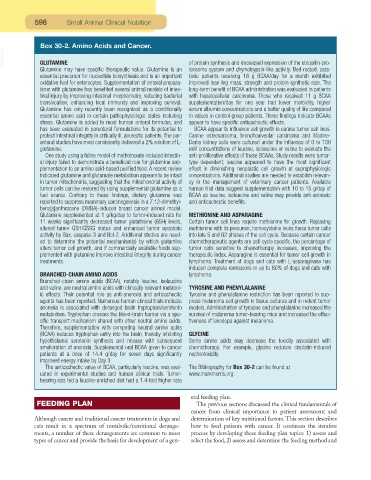Page 577 - Small Animal Clinical Nutrition 5th Edition
P. 577
598 Small Animal Clinical Nutrition
Box 30-2. Amino Acids and Cancer.
VetBooks.ir GLUTAMINE of protein synthesis and decreased expression of the ubiquitin-pro-
Glutamine may have specific therapeutic value. Glutamine is an teosome system and chymotrypsin-like activity. Bed-rested, cata-
essential precursor for nucleotide biosynthesis and is an important bolic patients receiving 18 g BCAA/day for a month exhibited
oxidative fuel for enterocytes. Supplementation of enteral prepara- improved lean leg mass, strength and protein synthetic rate. The
tions with glutamine has benefited several animal models of intes- long-term benefit of BCAA administration was evaluated in patients
tinal injury by improving intestinal morphometry, reducing bacterial with hepatocellular carcinoma. Those who received 11 g BCAA
translocation, enhancing local immunity and improving survival. supplementation/day for one year had lower morbidity, higher
Glutamine has only recently been recognized as a conditionally serum albumin concentrations and a better quality of life compared
essential amino acid in certain pathophysiologic states including to values in control group patients. These findings indicate BCAAs
stress. Glutamine is added to most human enteral formulas, and appear to have specific anticachectic effects.
has been evaluated in parenteral formulations for its potential to BCAA appear to influence cell growth in canine tumor cell lines.
protect intestinal integrity in critically ill, anorectic patients.The par- Canine osteosarcoma, bronchoalveolar carcinoma and Madine-
enteral studies have most consistently delivered a 2% solution of L- Darby kidney cells were cultured under the influence of 0 to 100
glutamine. mM concentrations of leucine, isoleucine or valine to evaluate the
One study using a feline model of methotrexate-induced intestin- anti-proliferative effects of these BCAAs. Study results were tumor-
al injury failed to demonstrate a beneficial role for glutamine sup- type dependent; leucine appeared to have the most significant
plementation to an amino acid-based purified food. A recent review effect in diminishing neoplastic cell growth at supraphysiologic
indicated glutamine and glutamate metabolism appears to be intact concentrations. Additional studies are needed to establish relevan-
in tumor mitochondria, suggesting that the mitochondrial activity of cy in the management of veterinary cancer patients. Available
tumor cells can be restored by using supplemental glutamine as a human trial data suggest supplementation with 10 to 15 g/day of
fuel source. Contrary to these findings, dietary glutamine was BCAA as leucine, isoleucine and valine may provide anti-anorexic
reported to suppress mammary carcinogenesis in a 7,12-dimethyl- and anticachectic benefits.
benz[a]anthracene (DMBA)-induced breast cancer animal model.
Glutamine supplemented at 1 g/kg/day to tumor-induced rats for METHIONINE AND ASPARAGINE
11 weeks significantly decreased tumor glutathione (GSH) levels, Certain tumor cell lines require methionine for growth. Replacing
altered tumor GSH/GSSG status and enhanced tumor apoptotic methionine with its precursor, homocysteine locks these tumor cells
activity by Bax, caspase-3 and Bcl-2. Additional studies are need- into late S and G2 phases of the cell cycle. Because certain cancer
ed to determine the potential mechanism(s) by which glutamine chemotherapeutic agents are cell-cycle specific, the percentage of
alters tumor cell growth, and if commercially available foods sup- tumor cells sensitive to chemotherapy increases, improving the
plemented with glutamine improve intestinal integrity during cancer therapeutic index. Asparagine is essential for tumor cell growth in
treatments. lymphoma. Treatment of dogs and cats with L-asparaginase has
induced complete remissions in up to 80% of dogs and cats with
BRANCHED-CHAIN AMINO ACIDS lymphoma.
Branched-chain amino acids (BCAA), notably leucine, isoleucine
and valine, are neutral amino acids with clinically relevant metabol- TYROSINE AND PHENYLALANINE
ic effects. Their potential role as anti-anorexia and anticachectic Tyrosine and phenylalanine restriction has been reported to sup-
agents has been reported. Numerous human clinical trials indicate press melanoma cell growth in tissue cultures and in rodent tumor
anorexia is associated with deranged brain tryptophan/serotonin models. Administration of tyrosine and phenylalanine increased the
metabolism. Tryptophan crosses the blood-brain barrier via a spe- survival of melanoma tumor-bearing mice and increased the effec-
cific transport mechanism shared with other neutral amino acids. tiveness of levodopa against melanoma.
Therefore, supplementation with competing neutral amino acids
(BCAA) reduces tryptophan entry into the brain, thereby inhibiting GLYCINE
hypothalamic serotonin synthesis and release with subsequent Some amino acids may decrease the toxicity associated with
amelioration of anorexia. Supplemental oral BCAA given to cancer chemotherapy. For example, glycine reduces cisplatin-induced
patients at a dose of 14.4 g/day for seven days significantly nephrotoxicity.
improved energy intake by Day 3.
The anticachectic value of BCAA, particularly leucine, was eval- The Bibliography for Box 30-2 can be found at
uated in experimental studies and human clinical trials. Tumor- www.markmorris.org.
bearing rats fed a leucine-enriched diet had a 1.4-fold higher rate
eral feeding plan.
FEEDING PLAN The previous sections discussed the clinical fundamentals of
cancer from clinical importance to patient assessment and
Although cancer and traditional cancer treatments in dogs and determination of key nutritional factors. This section describes
cats result in a spectrum of metabolic/nutritional derange- how to feed patients with cancer. It continues the iterative
ments, a number of these derangements are common to most process by developing these feeding plan topics: 1) assess and
types of cancer and provide the basis for development of a gen- select the food, 2) assess and determine the feeding method and

